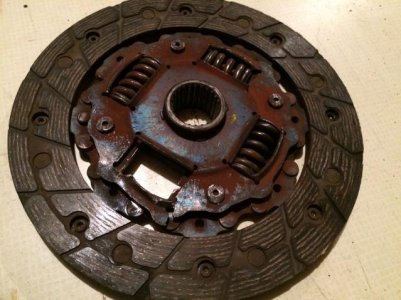So, my clutch 'failed' the other day and I'm looking for advice on what the problem might be. The car is a '91 with 191k miles and there's about 100k miles on the clutch but it hasn't been slipping and still pulls hard when it's engaged. I was turning a corner from a stop light and got on it a bit (maybe 5k rpm) and went to shift into second. The clutch just suddenly went to the floor .. very little resistance and although I was able to shift to second, it was quite hard to move the shifter. So, now I'm in problem diagnosis mode but continued on at about 30 mph for a few blocks with no issues and decided to turn into a shopping mall parking lot instead of gamble that I might stall at a light if the clutch wouldn't disengage.
So, I come to a stop with the clutch in and the motor running but having slid the shifter into neutral (not sure if I did this with the clutch's help or by brute force). But now I can't get it into any gear with clutch in and motor running. So, I shut the car off; shift into first; and try to start the car with the clutch in (not sure if that did anything) .. and it starts. But when I let the clutch out, the car doesn't move and the engine RPMs don't change. I was within blocks of home so we towed it home. I checked the clutch fluid reservoir and it seemed to be ok. No obvious leaking of hydraulic fluid in the driver footwell (which I gather is a sign of a leaking master cylinder). So, off to the dealer on a flatbed.
Based on several threads here lately, my first suspicion is either clutch master or slave (or both) or hydraulic linkage is gone. I know that there's probably not a lot left in the clutch but the high mileage is mostly highway and I never do any hard, clutch-slipping launches. Had the clutch imploded, I don't think I would have been able to drive it after it failed and there were no strange smells or noises. I did notice a slight audible chirp noise days earlier on a light load shift from second to third .. and duplicated it at constant road speed (no shifting) by just depressing the clutch and letting it out again. The thing that's a little odd is that I was able to start the car in gear with clutch depressed .. which I wouldn't have expected with a master/slave failure unless I don't understand how it works.
Current plan is clutch master/slave is on order and will likely be replaced later this week. No surprise with that mileage .. plus people are suggesting here that you do them both together. But I'm wondering what people's educated guesses are on whether this should fix things or not. Otherwise, the next step will be a new clutch and lots more $$. And I'll probably switch to aftermarket as I'm thinking of upping the HP next year.
Thoughts? Tks ...Ian
So, I come to a stop with the clutch in and the motor running but having slid the shifter into neutral (not sure if I did this with the clutch's help or by brute force). But now I can't get it into any gear with clutch in and motor running. So, I shut the car off; shift into first; and try to start the car with the clutch in (not sure if that did anything) .. and it starts. But when I let the clutch out, the car doesn't move and the engine RPMs don't change. I was within blocks of home so we towed it home. I checked the clutch fluid reservoir and it seemed to be ok. No obvious leaking of hydraulic fluid in the driver footwell (which I gather is a sign of a leaking master cylinder). So, off to the dealer on a flatbed.
Based on several threads here lately, my first suspicion is either clutch master or slave (or both) or hydraulic linkage is gone. I know that there's probably not a lot left in the clutch but the high mileage is mostly highway and I never do any hard, clutch-slipping launches. Had the clutch imploded, I don't think I would have been able to drive it after it failed and there were no strange smells or noises. I did notice a slight audible chirp noise days earlier on a light load shift from second to third .. and duplicated it at constant road speed (no shifting) by just depressing the clutch and letting it out again. The thing that's a little odd is that I was able to start the car in gear with clutch depressed .. which I wouldn't have expected with a master/slave failure unless I don't understand how it works.
Current plan is clutch master/slave is on order and will likely be replaced later this week. No surprise with that mileage .. plus people are suggesting here that you do them both together. But I'm wondering what people's educated guesses are on whether this should fix things or not. Otherwise, the next step will be a new clutch and lots more $$. And I'll probably switch to aftermarket as I'm thinking of upping the HP next year.
Thoughts? Tks ...Ian







